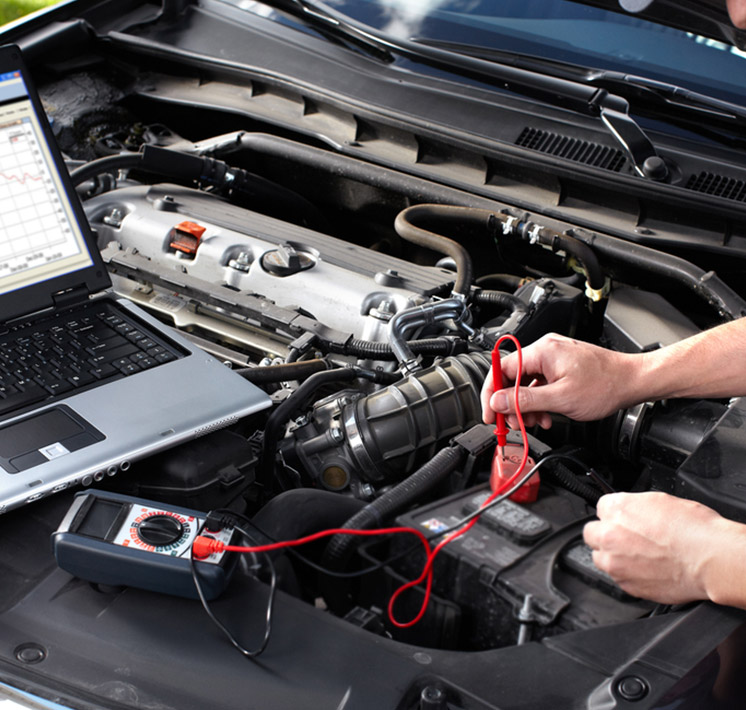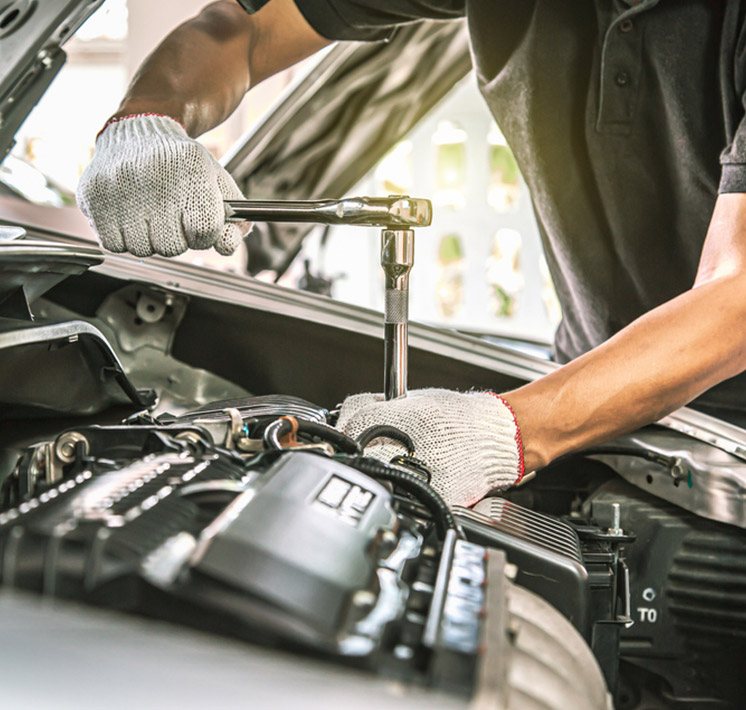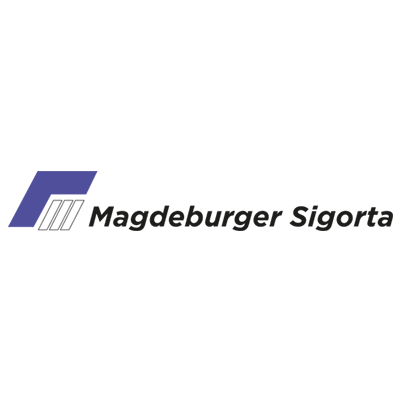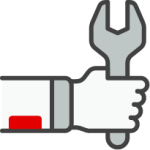REPAIR
INSTEAD OF CHANGE
Mechanical Maintenance and Repair
Mechanical parts are not worn and deteriorated simultaneously and in the same way, due to the use of motor vehicles in different conditions, speeds, loads and styles. Detection and diagnosis of worn out, wear and deterioration faults occurring in Motor Vehicle parts are made with ALC Diagnostic / Check Up service.
In this context, 3 (three) different service packages are offered to the consumer.
1- Fault Detection with Diagnostic Device:
There are control units that work together with the electronic system parts on the vehicle. Control units take information from the sensors on the vehicle and control other system parts and the operation of the engine as a result of various evaluations. For example, the engine control unit manages the fuel and ignition system through injectors or spark plugs by receiving information from many parts on the vehicle such as temperature sensor, lambda sensor, air mass measurement sensor, crankshaft speed sensor. All kinds of measurements, fault detection operations, error code reading, error code deletion, adaptation made over these control units are called diagnostic.

Why is it important?
Engine, Fuel, ABS, EBD, ESP, AIRBAG etc. within the framework of the brand and model features of the vehicle. There is information flow from the electronic sensors to the Control Unit (Brain) of the vehicle. This information may be performance, malfunction or informational. In order to access the information recorded in the vehicle’s control unit (Brain), the Diagnostic Device is connected to the vehicle’s Control Unit via the connection sockets, the information recorded in the Control Unit (Brain) is read, and the information is analyzed and fault detection is provided. Within the scope of this service, detection and data can be printed out via the printer connected to the Diagnostic Device.
2- Fault Detection with Hand and Eye:
Detection of some of the malfunctions in the vehicles (Front assembly malfunction, fluid leaks, oxidation, suspension system malfunctions and connection gaps, etc.) cannot be done electronically with the Diagnostic Device. Detection of such malfunctions is done manually and visually by means of hand tools and equipment. Fault detection with hands and eyes can be done on the lift and/or on the ground.
3- Fault Detection with Test Drive:
A certain part of the malfunctions in the vehicles are detected by the vehicle driver during the city. Detection of such malfunctions is made by means of a Test Drive with the vehicle, thanks to the same driving conditions in line with the information conveyed by the vehicle driver. If a Test Drive is possible, doing it together with the vehicle driver will speed up the fault detection process.
Test Drive is made by ALC Mechanical Technician and with customer approval on the shortest route. The test drive is carried out not only to detect malfunctions, but also to test the results of the maintenance and repair processes that have been applied.
Engine Oil and Filter Change
ALC Oil Change Service helps you protect the vehicle’s engine. Any expense incurred on the vehicle is to keep it on the road as long as possible. Engine oil is an element that directly affects the performance, fuel consumption and emission of the vehicle.
ALC Oil Change Service is not only a simple oil change process, but also for preventive maintenance; replacement, checking the main components, filling the missing fluids and cleaning the necessary components.
Engine oil; must cope with these operating conditions in order to protect the engine against wear, corrosion, and the formation of dirt and debris. Engine oil is an element that directly affects the performance, fuel consumption and emission of the vehicle. The task of engine oil is to prevent wear, to clean the engine and to prolong engine life.
The task of the Engine Oil Filter is to ensure that the particles and abrasive foreign substances that can damage the engine mixed into the engine oil during engine cleaning are cleaned so that the engine oil can do its job well.
Why is it important?
During engine operation, carbon deposits form on the combustion chamber surfaces. These carbon deposits break down into the oil and cause gumming. Gummy residues, acids, resinous residues formed as a result of fuel combustion are also seen in engine oil operating under high temperature. Although the engine has an oil filter, some of the impurities remain in the oil without being filtered. These foreign substances remaining in the engine oil cause engine wear, increase fuel consumption and decrease the performance of the vehicle. For this reason, the engine oil and oil filter must be changed periodically.
Transactions within the scope of the Service:
- Change:
- Engine oil
- Oil filter
- Control:
- Control of Vehicle Fluids
Visual And/or Device Check – Checking the fluid level with the dipstick or visual, Checking the fluid change mileage from the change card, Checking the leakage and visual condition of the fluid
- Transmission oil
- Brake hydraulic oil
- Steering hydraulic oil
- Wiper fluid
- Coolant and Antifreeze
- Battery Water Level (If wet type)
- Checking Belts:
Eye and Hand Check – Check for fraying, looseness
- Alternator Belt
- Air Conditioning Belt
- Steering Pump Belt
- Water Pump Belt
- Control of Filters:
Eye and Hand Control – Wear, contamination control
- Air Filter
- Air Conditioning (Pollen) Filter
- Fuel Filter (Internal)
- Lighting Elements Control:
Eye and Hand Check – Fracture, damage checks and functional operation check of systems
- Headlights;Long & Short & Park
- Reverse Light
- Stop (Brake) Lamps
- Fog Lights (if equipped)
- Quad Warning Lights (Blinker)
- Checking the Wiper Blades
- Checking Tire Pressures
ALC; As engine oil, it provides effective fluidity at low temperatures, consistency at high temperatures and strong engine protection against residues. It uses synthetic engine oil that provides economy and a longer engine life.
Oil filters are used in brands recommended by the vehicle manufacturer as oil filters.
Periodic Maintenance
automobiles; It was created by bringing together many mechanical, electrical, electronic parts and some components used in some of these parts. According to the use of automobiles and the way of use, wear, deterioration, corrosion, etc., on the parts that make up the automobile, over time. physical damage has occurred; It is seen that the properties of chemical substances change, the strength of the parts decreases and loses their properties at certain time intervals. For these reasons, it has been determined that the strength and working performance of the parts have decreased and the adjustments made on the parts have deteriorated. For the stated reasons, it is necessary to carry out checks, adjustments and replacements on motor vehicles at regular intervals. All of these processes are called PERIODIC MAINTENANCE.
Why is it important?
The purpose of periodic maintenance; to maintain vehicle performance in the best possible condition, to eliminate minor problems that may cause major malfunctions, to ensure that the vehicle operates and is safe in accordance with laws and regulations. By performing periodic maintenance, vehicles can be long-lasting, fuel economy and safer operation can be achieved.
How Often Should It Be Done?
The maintenance periods of the vehicles are made at the times determined by the manufacturers (usually 1 year) or at the specified periods (10,000/15,000, 20,000/30,000, 30,000/45,000 ….km). During these maintenance periods, the fluids, filters, adjustments and mechanical parts in the vehicles are maintained, checked, adjusted and changed.
Recommended Periodic maintenance intervals:
- Under normal usage conditions;
- Diesel vehicles: 10,000 km. or 12 months,
- Gasoline vehicles: 15,000 km. or 12 months
- In difficult usage conditions;
Driving in congested traffic, rough, bumpy, potholes, rough, dusty roads, extreme cold or extremely hot variable climatic conditions, humid and high altitude regions, mountainous regions and off-road conditions, long-term excessive speed and/or high speed use) ,
- Diesel vehicles: 5,000 km. or 6 months,
- Gasoline vehicles: 7,500 km. or 6 months
Within the scope of ALC Periodic Maintenance service;
- Engine oil and oil filter change
- Air filter change and/or check
- Air conditioner (Pollen) filter change and/or control
- Fuel filter change and/or check
- Engine maintenance and control
- Control of liquids
- Brake maintenance
- Headlight adjustment and control of lighting
- Forehand control
- 55 Point Check-up
Transactions are made.
Brake System Maintenance and Repair System
The brake system is the most important part of a safe driving, which ensures that the vehicle can stop effectively and safely. A well-maintained braking system protects the driver, passengers and others sharing the road.
Why is it important?
The working principle of the brake system is that the foot force applied to the brake pedal during braking creates the pushing force on the pedal. This movement pushes the piston of the master cylinder. The thrust on the piston is transmitted to the brake wheel cylinders through the fluid in the system. Brake wheel cylinders hydraulic pressure is transmitted to the brake shoe.
The friction force created in the brake wheel mechanism is used to stop the vehicle. In the meantime, friction occurs between the elements that make up the system. Periodic control of friction materials, brake fluid and other important system parts will contribute to the most effective maintenance of the performance of the brake system and to reduce the maintenance cost.
The brake system, which must be checked every 10,000 or 15,000 km, allows possible accidents to be avoided.
ALC Brake Maintenance and Repair Service starts with checking the brake pads and their main parts. Detailed findings are shared with the customer. Service recommendations are made based on manufacturer specifications and the current condition of brake parts, which affects system performance.
How Often Should It Be Checked?
Brake Pads: Brake pads are the first wear parts in the brake system. Therefore, the brake pads are checked first with the eye and then with the measuring device. It should be changed when the lining thickness drops to a minimum of 2.0 mm. (approximately 30,000 km in relation to driving style) Brake pads in poor condition cause disc wear and loss of vehicle control during sudden braking.
Brake Discs: Brake discs are especially difficult during braking, this is because the brake pads are rubbing against the discs. For this reason, the brake discs are checked first with the eye and then with the measuring device. Brake discs need to be replaced when they reach the minimum thickness determined by the brake disc manufacturer (≈2.2mm) or when the runout of the disc reaches the maximum level (≈0.05mm) and the runout cannot be removed after turning. At an average of 80,000 to 100,000 kilometers depending on your usage. One of the factors that cause the brake disc to deteriorate is keeping cold water on the hot disc surface.
Brake Shoes They should be checked and dusted approximately every 30,000 kilometers.
Brake Fluid: Manufacturers recommend that the brake fluid be changed completely every 2 years or 40,000 kilometers. Measurement of the boiling temperature of the brake fluid oil, a premature change can be made according to the driving conditions. Brake hydraulic oil control is made from the hydraulic oil change information card or with a measuring instrument.
Shock Absorber and Suspension System Inspection and Replacement
Vehicle suspension system; It is a system that carries the weight of the vehicle by placing it between the body and the wheels of the vehicles, provides driving comfort and safety, absorbs the vibration, oscillation and sudden shocks caused by the road surface, and ensures the vehicle to hold on to the road at the maximum level during driving and turning.
Vehicle suspension system; It consists of Shock Absorber, Coil Spring, Balance Bar and, in some vehicles, Scissors.
Since the vehicle suspension system works integrated with the undercarriage of the vehicles, the control of the system;
- By Eye
- By Hand
- With Device (With External Supplier for Shock Absorbers)
- It is done with a Test Drive.
Visually inspect for cracking, bending, tearing, torsion, leakage and worn-out parts. Afterwards, the fasteners and the tightness of the connecting bolts are checked manually.
The test drive is carried out not only to detect malfunctions, but also to test the results of the applied repairs.
The symptoms of Bad Suspension system are as follows.
- Steering becomes stiff.
- The suspension softens.
- The grip is weak.
- The vehicle skids on wet ground.
- The steering wheel vibrates.
- Night vision is bad.
- Tires are uneven and wear out quickly.
- Driving becomes difficult.
- Brakes are weak.
Air Conditioning System Control and Air Conditioning Gas Filling Service
Air conditioning is an indispensable accessory in the sweltering heat of summer. However, since the air conditioner of the vehicle is dark and humid environments, they are suitable places for mold and fungus growth. That’s why car air conditioners, which are neglected in the winter months, can cause diseases in the summer months by providing an environment for mold and bacteria formation.
The air conditioner compressor, which is powered by the engine by means of a belt, presses the refrigerant gas into the cooling system, increasing its pressure and pumping it into the system. The gas is pushed into a valve where its pressure and temperature drops. The new cooled gas circulates in the evaporator in the passenger compartment. As a result, the air cooled by the gas is blown into the vehicle, cooling the cabin interior. The circulating gas returns to the compressor and starts its cycle all over again. Although air conditioner repair is an expensive service, it can be saved from possible costs with the precautions to be taken and the maintenance to be done in certain periods.
ALC Air Conditioning System Control and Air Conditioning Gas Filling Service provides to increase the cooling efficiency of the air conditioner for a more comfortable cabin environment.
Within the scope of the service;
- Visually inspect the A/C compressor belt for cracks and damage.
- Leakage and damage control is performed on accessible parts.
- Check the operation of the air conditioner compressor and other air conditioner parts
- Existing refrigerant is discharged from the system.
- Vacuum test and leak test are performed in the system
- The air conditioner (pollen) filter is checked.
- The gas with the specifications and amount recommended by the manufacturer is filled into the system.
Control of vehicle air conditioning and cooling system;
- By Eye
- It is done with the device.
First of all, the cooling system is started and after about 5 minutes, the temperature of the air cooled by the air conditioner is measured from the cold air discharge channels in the vehicle by means of the thermostat. If the air conditioner is not cooling enough or not at all, the possible reasons are;
- Gas leak; Whether there is a gas leak in the air conditioner gas pipes is checked with the eye and the Air Conditioner Gas Leak Detector. If there is a gas leak, the source is identified and replaced or repaired. Afterwards, the air conditioner gas is filled with the Air Conditioner Gas Filling Device.
- If there is no gas leakage, it is checked for dirt on the air conditioner radiator and whether the radiator is clogged due to corrosion.
- If there is no problem with the radiator, the radiator fans are checked.
- The Air Conditioner (Pollen) Filter is checked to see if it is dirty and clogged, after the check, the filter is either cleaned or changed. If the Air Conditioner (Pollen) Filter is dirty, it will cause a bad smell inside the vehicle when the cooling system is started.
Clutch System Check and Clutch Kit Replacement
Clutch System; In vehicles with manual driving feature, it is the transmission system that ensures the smooth movement of the vehicle by transmitting the movement of the engine to the wheels during the first start, changing the gear states while in motion, and stopping the vehicle in a controlled manner by applying the engine brake (compressor) when necessary. The replacement of the clutch system parts is 75,000 km, depending on the conditions and conditions of normal use, according to the manufacturer’s recommendations.
In the maintenance of the Clutch System, primarily the test drive and the clutch and gear shift test of the vehicle are performed. As a result of the test, it is checked whether the vibration, shaking and clutch pedal clutch level are at the upper limits during take-off. If a malfunction is detected in the system, the Pressure, Brake Lining and Ball that make up the Clutch System are changed as a set. The gearbox oil level is checked and if there is a deficiency, it is completed. The results of the repair processes applied with the test drive are tested.
Transmission Fluid Check and Change
Transmission (Gearbox) gear shifts provide the most appropriate power and efficiency for your speed of use. As a result of the contact of the gears in the gearbox with each other, friction and wear occur.
Hence;
- Creating a protective film layer between gears,
- To minimize the abrasions caused by friction,
- To prevent damage by cooling the gears,
- To provide protection against corrosion,
- Cleaning the gears of the gearbox,
For this purpose, the transmission (Gearbox) oil level should be checked periodically, if necessary, it should be completed and changed every 75,000 km, depending on the conditions and conditions of normal use.
Fuel and Ignition System Check
The fuel and ignition system is a system that enables the vehicle to operate at a high efficiency and standard with the least amount of fuel by controlling the instantaneous fuel, emissions and other variables of the engine at different times and conditions by means of electronic control units. Apart from the routine maintenance of the vehicles, unexpected breakdowns and serious costs may occur due to the fuel used in the fuel and ignition system, delayed periodic maintenance, unconscious maintenance and repair with unsuitable materials, vehicle usage style and adverse conditions.
Fuel and ignition system;
SPARK PLUG: It ignites the Gasoline – air mixture compressed by the high voltage coming from the distributor. The average efficient life of spark plugs is 12,000 km.
INDUCTION COIL: It is the circuit element that increases the l2 volt current of the battery to 15-25 thousand volts.
DISTRIBUTOR : It sends the high voltage (15-25 thousand volts) formed in the induction coil to the spark plugs according to the ignition order.
FUEL PUMP: It is the element that absorbs the fuel from the tank and sends it by pumping it to the injectors under a certain pressure.
FUEL FILTER: It is expected to be changed in periodic maintenance.
INJECTORS: It is necessary to perform a cleaning of 40.000km in gasoline vehicles and 30.000km in Diesel vehicles.
In the Fuel and Ignition System control, starting from the fuel tank of the vehicle, the fuel pipes are visually checked for leakage and damage. With the Diagnostic Device, the vehicle’s exhaust emission values are measured and it is checked whether they are within the standards. During this measurement, Spark Plug, Injector, Oxygen Sensor, Catalytic Convector, Fuel and all ignition system sensors are checked. Necessary changes, cleaning and/or repairs are made.
Cooling System Control
The task of the engine cooling system; It is to prevent overheating of engine parts and engine oil, to raise the engine to the most efficient heat as soon as possible and to keep the engine at operating temperature to give full power.
Regardless of the operating conditions, the cooling system should run the engine at the most efficient temperature. During engine operation, parts such as cylinder walls, pistons and cylinder head also absorb a large amount of heat. If these parts of the engine get too hot, the oil film burns and the oil layer loses its lubricating property, so the engine may be damaged. Complete cooling of the engine to eliminate negative effects is also not the solution. Because the engine cannot give the desired power before it reaches the operating temperature. Oil gets dirty, deposits form, fuel consumption increases, so the cooling system is designed not to be activated until the engine reaches operating temperature. Therefore, the cooling system should keep the engine at regime (normal operating) temperature.
Cooling Systems are of 2 (two) types.
- Air cooling systems
- Liquid cooling systems (car engines are usually liquid cooled)
In liquid-cooled engines, coolant (a mixture of pure water and antifreeze) is generally used as the coolant. In liquid-cooled engines, the heat generated inside the engine is taken by the engine coolant and cooled in the radiator. The cooling water is circulated through the water pump. The hot engine coolant in the radiator is cooled by the naturally incoming air with the rotation of the radiator fan or when the vehicle moves forward.
The biggest enemy of the radiator is the mains water!
Lime and other minerals in the mains water not only quickly clog the radiator cores, which are quite narrow, but also reduce the cooling performance by covering the water channels in the engine block. In summer and winter, antifreeze MUST be used. Antifreeze not only prevents the water from freezing, it also prevents the formation of corrosion with its additives, allows the liquid to cool faster and allows your water pump to work more comfortably.
The ideal replacement period for the coolant is one year. If there is a deficiency in the coolant during the controls other than the replacement, the coolant level is completed by adding pure water/antifreeze. In addition, the degree of coolant is determined with the antifreeze boommeter and necessary fluid adjustments are made.
Other system elements checked within the scope of Cooling System Control;
RADIATOR: It stores engine coolant. It allows the heat in the cooling water to pass into the air during the movement of the water on the radiator.
THERMOSTAT: It is an automatic valve placed in the cooling system of the engine. When the engine is cold or below the operating temperature, it disables the radiator by preventing the passage of water and ensures that the engine reaches the appropriate operating temperature quickly.
WATER PUMP (Circulation): It is the element that pumps the cooling water in the radiator to the water channels in the engine.
FAN : By creating a strong air flow between the radiator cores, it accelerates the cooling of the heated water. On some vehicles, the fan is connected to the crank pulley by a V-belt.
MUSIR: It is a button that closes its open contact or opens its closed contact when the measured temperature or pressure reaches the specified value.
DRIVE (V ) BELT: It is the belt that transmits the movement it receives from the crank pulley to the alternator, circulation (water pump) and fan.
Drive (V) Belt Inspection and Replacement
Motion transmission (drive) belts transfer the engine power they receive from the crankshaft pulley to units such as Water Pump, Cooling Fan, Alternator, Power Steering Oil Pump and Air Conditioning Compressor.
Drive belts are elastic when new and have high strength. When they start to be used, the belts harden over time. For this reason, cracks begin to form in their internal structures and these cracks become visible in advanced stages. At the same time, they wear out, their strength decreases and they become loose. Drive (V) belt loses its feature over time. While this part, which loses its flexibility, transmits the movement it receives from the crankshaft to the alternator, air conditioner motor, power steering pump and cooling system pump, it affects the rotational balance of their pulleys.
It also causes the failure of expensive parts such as alternator, air conditioner motor. If the V-belt breaks while the vehicle is in motion; The alternator cannot meet the electricity need, the inoperative cooling system pump causes the engine to overheat. Apart from breaking the V-belt, it is risky for the engine if it is not in ideal tightness.
Therefore, periodic inspection and replacement of drive belts is a must.
Electrical and Electronic System Control
1- Control of Warning, Lighting and Signal Lamps:
These are systems that are vital for the driver to use the vehicle safely. Bulbs are generally used in vehicles in the warning, lighting and signal system. However, LED illuminated signals or brake lights are used in new generation vehicles. The lighting lamps outside the vehicle are covered with a transparent or colored transparent cover made of thermoplastic.
Why is it important?
In the systems, there are usually bulb explosions, oxidation and disconnections in the cable and socket sockets, problems with the fuses, or flasher and relay failures. These warning and warning lamps, which are also checked during visa inspections, should be checked during periodic maintenance and fixed if malfunctions are found.
How Often Should It Be Checked?
The vehicle must be checked every time it is used.
2- Battery Control:
The battery in your vehicle; It is a generator that stores electrical energy as chemical energy and converts chemical energy back to electrical energy and gives it to the receivers. It is used to meet the electrical needs of the electrical energy-operated systems in your vehicle. Your vehicle’s battery; In the process of starting the engine, it supplies power to the starter, ignition system, fuel system and other electrical equipment. Also, energy stores, digital radio, clock, alarm, trip computer etc. It supplies power to electronic components such as
In Battery Control;
- Holes, cracks, breaks, crushing and melting in the battery box and cover,
- In polar heads, bending due to melting and impact,
- Congestion in element dust caps,
- the electrolyte level of the battery,
- It is checked periodically to see if there are substances on the battery that may cause short circuits on the terminals.
Moreover;
- With Battery Tester
- Charge Level
- Loading Test is being done.
After the visual inspection, the voltage of both types of batteries is checked with a digital battery tester. As a result of the checks, if there is a low voltage, the battery is charged by the battery charger. If the amount of acid is missing in well-maintained (wet) batteries, battery water is added. If the faults in the battery cannot be eliminated as a result of the actions taken (battery does not charge or does not hold charge), the battery is replaced.
The approximate lifetime of the battery may vary between 2 and 4 years.
3- Controlling the Headlight Adjustment:
In order for the driver to drive the vehicle safely, the headlight settings of your vehicle must be correct in order to provide better night vision, not to be disturbed by the headlights of the oncoming drivers and to illuminate the road in the best way possible.
Correct lighting is important for the protection of electrical systems as well as driving safety.
Why is it important?
The adjustment of the headlights of your vehicle may deteriorate over time due to the vibration of the vehicle and the use of the vehicle with and/or without a load. The settings made when the headlight settings are empty at the factory of the vehicles can illuminate the wrong places when the car is loaded, so it should be checked at certain intervals. Headlight adjustment should be done with a headlight adjustment device compatible with the headlight feature of your vehicle. Other than the headlight adjustment device, manual headlight adjustments can be made as a temporary solution and carries the risk of damaging the electrical system.
4- Maintenance and Charge Control of Alternator:
The charging system converts the mechanical energy it receives from the engine into electrical energy and ensures that the electrically powered receivers are fed and the battery is constantly charged. The charging process of the receivers [battery, alternator, regulator (conjector) and charge indicator] is carried out by the charging system. When the vehicle engine is not running, the electrical energy required for the operation of the receivers is supplied by the battery. However, it cannot continuously feed the receivers as it is limited by the battery capacity. Therefore, the batteries must be charged from an electrical source and the receivers must be fed. The charging system performs this task. The most important part of the charging system is the alternator. The alternator, just like the engine of your vehicle, needs certain periodic maintenance. For example, coals have a certain life and their bearings need to be checked.
Many alternator faults are easily detected once they start, with some care. Alternator failures can be either mechanical or electrical. If electrical faults are not corrected in time, they may primarily damage the battery and all electric vehicles in the vehicle. In electrical faults, the problem is most likely caused by exhausted coals or blown diodes.
Mechanical failures are manifested by grinding sounds and whining sounds. In most of the cases the problem is the bearing or bearings inside the alternator. If the bearings fall apart, the alternator will be damaged beyond repair; it will even damage the surrounding parts.
5- Control of Fuse and Relays:
Fuses protect the electrical circuit against high current. These are the elements used to protect the system against possible fire hazards at the end of a short circuit that may occur in the electrical circuits of the vehicle. When the fuse blows, a new fuse of the same amperage is inserted in its place.
Relays are switches used to safely switch the system, especially in circuits with high current (headlight, horn).
6- Starter Motor Control:
The system created to activate your vehicle’s engine for the first time is called the Starting System. Starting system generally consists of battery, ignition switch, starter motor, starter switch or starter solenoid, flywheel and flywheel gear. starter motor; It is a direct current electric motor that converts electrical energy into circular motion. The circular motion created by the starter motor is transmitted to the flywheel with the help of the starter gear. The starter motors of the starter motors, which are necessary for the first start of the vehicle, do not need frequent maintenance. The most important and most frequent maintenance is keeping the battery charged and checking that the battery and starter connections are clean and tight.
Tire Maintenance and Periodic Relocation (Rotation)
Tires are a chemical product, the basic structure of which is synthetic rubber, which provides controlled stopping of the vehicle at the start, safe ride, comfort and braking by transmitting the engine movement to the road. Theoretically, all tires should show the same amount of wear. If a tire is used in the same place for a long time, it shows wear specific to the location in which the wheel is used. Generally, front tires of front wheel drive vehicles wear 10-20% more than those in the rear. The tire shoulders (tire sidewalls) are the parts that wear the fastest. Tires should be replaced regularly. Thus, it is ensured that all of them wear evenly and properly. This also extends tire life. If the radial tire is replaced with one on or opposite the opposing tire, the tire noise and yaw will be temporarily impaired. Because it rotates in the opposite direction from its previous position. It is therefore recommended that radial tires stay on their side during rotation. Tires are primarily visually checked for wear and tear on the tire surface, and the durability of the air valves.
The tread thickness of the tires is measured.
Summer Tire : min. 2mm
Winter Tire : min. 4mm
Winter Tire : min. 4mm
If a measurement is made below the specified minimum values, the tire should be replaced with new ones with suitable features, taking into account the vehicle manufacturer’s recommendations.
If the driver of the vehicle has vibration in the tire (unbalance), etc. complaints are evaluated and the tires are removed and the balance of the tires is adjusted with the Balancing device. If the rim is damaged or a situation requiring repair is detected during the balancing, after the rim repair is done, the tires are mounted on the rim and the balance is adjusted.
Windshield Wiper Replacement Service
Windshield wiper blades are made of a soft rubber compound. Over time, the structure of the rubber composition deteriorates and becomes brittle. In such a case, the wipers leave lines on the glass, negatively affecting your vision. Within the scope of the Engine Oil and Oil Filter change service, your vehicle’s wiper blades are checked and you are informed about the cracked, torn or hardened wiper blades that are due for replacement.
Check-Up Services
The biggest concern of vehicle owners in terms of buying and selling second-hand (used) vehicles or determining the current condition of their vehicle is the inability to determine the condition of their vehicle or the vehicle they will buy. Concern about technical risks such as whether the vehicle has had an accident or not, if it has, the severity of the accident, whether the vehicle has a mechanical failure or not. Within the scope of ALC Check Up Service; According to the ALC Check Up Form, the vehicle is checked.
ALC Check Up Services;
- 26 Point Check Up Service (It is a free check-up service that is recommended.)
- 55 Point Check Up Service
- 99 Point Check Up Service

Our Business Partners












































